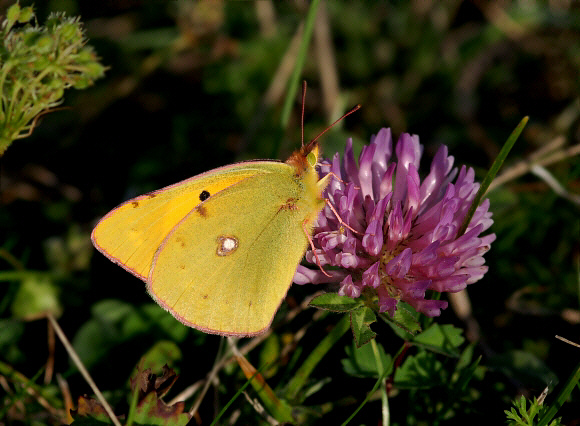 Clouded Yellow Colias crocea, Beachy Head, East Sussex – Adrian Hoskins
Clouded Yellow Colias crocea, Beachy Head, East Sussex – Adrian Hoskins
Introduction
In the early days of English entomology the male of this beautiful insect was known as the Saffron butterfly, and the female was called the Spotted Saffron. The name Clouded Yellow was given to it in the 18th century, and may well have been derived from the expression “cloud of yellows”, as the butterfly migrates to Britain in swarms, and has often been reported as seen migrating across the English Channel as a cloud of yellow over the sea. There is a famous account by Rev. Harrison, who in 1868, at the age of 11 sat on a cliff near Marazion, Cornwall, and observed “a yellow patch out at sea, which as it came nearer showed itself to be composed of thousands of Clouded Yellows, which approached flying close over the water, rising and falling over every wave till they reached the cliffs, when I was surrounded by clouds of Colias ( crocea ) which settled on every flower….”.
The Clouded Yellow is an abundant and widespread butterfly in North Africa and the Mediterranean region, from where it migrates north-wards each year. Migrations usually follow the same route, starting in north Africa and then heading north through Spain and France, with the bulk of migrants entering Britain along the coast of Dorset. Smaller numbers migrate across from Tunisia to Italy, then east around the Alps, entering Britain via Kent, Essex and Suffolk.
Numbers arriving in the UK vary from year to year. In some years no more than a couple of dozen are recorded, but about once every decade much larger numbers arrive, the most famous invasion occuring in 1947. Then, as quoted by CB Williams in his book Insect Migration, a Mr Blake, aboard a ship in the English Channel in October of that year, recorded that “for many miles he saw Clouded Yellows over the sea”. He estimated that “the flight was on a front of about 50 miles, and that there must have been well over a hundred thousand butterflies taking part”.
The first wave of immigrants usually arrives in southern England in early May and produces a new generation of butterflies that emerge in July and August. These are often supplemented by a second wave of immigrants – the progeny of butterflies that bred in France, which may arrive at any time during the summer. In very warm summers there may be a further UK-bred generation emerging in September, October or even November. There is evidence that butterflies emerging in central and northern England may sometimes undertake a return southward migration.
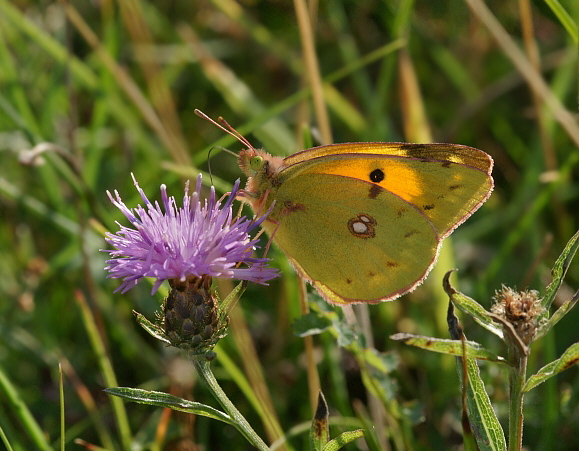 Clouded Yellow Colias crocea, female, Beachy Head, East Sussex – Adrian Hoskins
Clouded Yellow Colias crocea, female, Beachy Head, East Sussex – Adrian Hoskins
In very mild winters e.g. 2006-2007 the Clouded Yellow can successfully over-winter in the larval stage at certain sites along the coasts of Dorset, Hampshire and the Isle of Wight. Consequently a small number of adults may emerge as early as February. Normally however the species perishes with the onset of winter.
Clouded Yellows of both sexes normally have deep yellow uppersides with broad black margins, but the females have a row of pale yellow spots within the margins. About 5% of females are of a paler whitish ground colour. These are known as var. helice, and are commonly mistaken for females of the very much rarer Pale Clouded Yellow and Berger’s Clouded Yellow. In both of the latter species however the upperside is a beautiful primrose yellow, and the hindwing borders are much narrower.
In Europe there are no less than 12 Colias species, several of which are difficult to tell apart in the field. Identification is further confused by the presence of sterile hybrids ( e.g. erate x crocea ) in areas where the distribution range of the species overlaps.
NB : The name crocea replaces the earlier name croceus which is regarded as invalid.
Habitats
The migratory nature of the Clouded Yellow means that it can be encountered in almost any habitat. It penetrates well inland, and can be found as far north as the Outer Hebrides. The highest numbers however occur along the southern counties of England, particularly in Devon, Dorset, East Sussex and on the Isle of Wight. Hampshire generally receives fewer Clouded Yellows than these counties, probably because many migrants are diverted around the Isle of Wight coast to Dorset or Sussex.
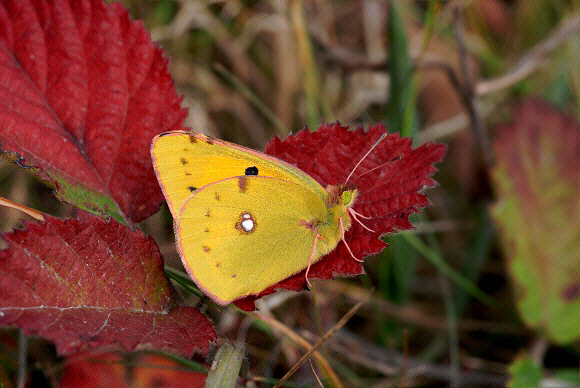 Clouded Yellow Colias crocea male, Beachy Head, East Sussex – Adrian Hoskins
Clouded Yellow Colias crocea male, Beachy Head, East Sussex – Adrian Hoskins
The butterflies breed in a wide range of habitats including cultivated lucerne fields, clover-rich farm headlands, steep well-drained chalk and limestone grasslands, abandoned quarries, road and rail embankments – anywhere in fact where the foodplants grow in profusion in a warm dry habitat.
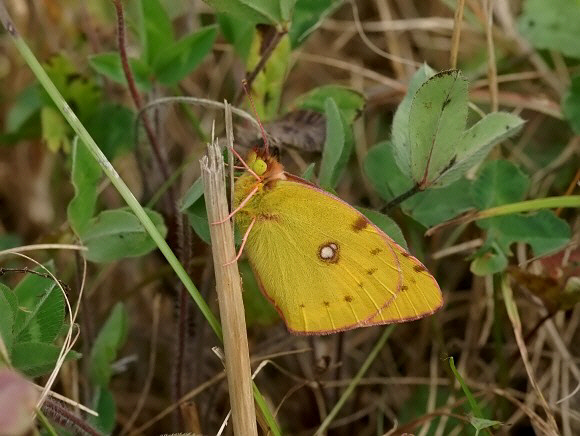 Colias crocea, freshly emerged male, Beachy Head, East Sussex – Adrian Hoskins
Colias crocea, freshly emerged male, Beachy Head, East Sussex – Adrian Hoskins
Lifecycle
The butterfly is multi-brooded in warmer parts of it’s range, but in Britain it normally produces only a single generation, emerging in July and August – the progeny of adults that migrated northward from the continent in May or June. In particularly warm summers there is often a partial 2nd brood that emerges in October. These late emerging adults and any resulting eggs or caterpillars normally perish in early winter, but at a couple of sites on the south coast caterpillars occasionally overwinter successfully, producing a few adults in February or March.
The eggs are laid singly or occasionally in two’s or three’s, on the upper surface of leaflets of red clover Trifolium pratense, lucerne Medicago sativa, horseshoe vetch Hippocrepis comosa, bird’s foot trefoil Lotus corniculatus, sainfoin Onobrychis viciifolia, kidney vetch Anthyllis vulneraria, or black medick Medicago lupulina. They are pale yellow at first, quickly turning to pink and finally to orange. They hatch after about 7 – 10 days.
Clouded Yellow larvae are rough textured, dark green in colour, with a pale yellow lateral stripe and orange dashes between the spiracles. They feed diurnally on the leaves of the foodplants.
Larvae hatching in May and June feed up and become fully grown within about 3 weeks but those of the 2nd brood feed very and usually perish with the arrival of the first frosts in early November. In warmer regions of Europe they continue to feed during the winter months, and do not enter a state of diapause.
The pupae are yellowish green, marked on the wing cases and abdomen with tiny black dots. They are extremely difficult to find in the wild, attached by the cremaster and a fine silk girdle to stems of the foodplants or other nearby plants. The adults emerge after about 18 days.
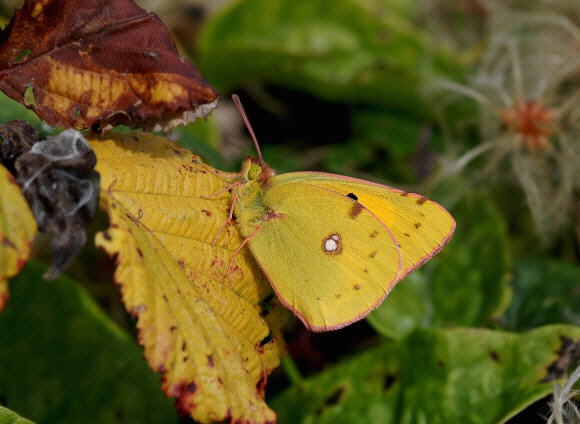
Clouded Yellow Colias crocea, male, Beachy Head, East Sussex – Adrian Hoskins
Adult behaviour
Both sexes fly very rapidly and purposefully, migrating in search of breeding sites, stopping for a day or two to refuel at nectar-rich hillsides. Once they discover a suitable area with an abundance of the larval foodplants they tend to remain for several days.

Clouded Yellow Colias crocea, male at roost, Cissbury Ring, West Sussex – Adrian Hoskins
On warm summer days they spend long periods flying restlessly from flower to flower, nectaring at small scabious, field scabious, devil’s bit scabious, knapweeds, cat’s ear, stemless thistles, mouse-ear hawkweed, marjoram, clovers, trefoils and vetches.
When feeding they remain extremely alert, and rarely settle for more than 3-4 seconds at a time. A minor and temporary drop in temperature however is sufficient to invoke a resting phase when they settle in rabbit scrapes or other depressions where they may remain stationary for several minutes.
On sunny mornings males patrol back and forth over the breeding sites, exhibiting a regular cycle of nectaring, resting and searching for potential mates. Females are nearly always mated prior to their maiden flight. I often find copulated pairs in which the females still have limp wings and have clearly only just emerged. The butterflies remain joined for about 1-2 hours during which time they usually remain stationary, hidden among grasses. Nevertheless if disturbed they readily take flight, with the male carrying the female. Normally they resettle nearby among herbage, or on bushes, but I have known them to fly up to land high in the tree tops.
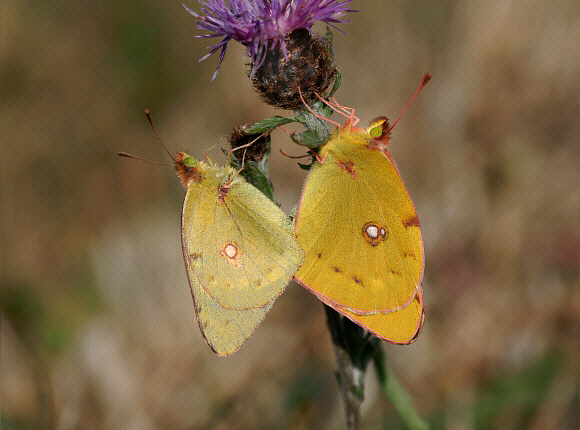
Clouded Yellow Colias crocea ( female on right ), Beachy Head, East Sussex – Adrian Hoskins
In October 2009 at Beachy Head in Sussex I watched a male pounce on a freshly emerged resting female. He danced around her, then landed behind her and tried to walk into the gap between her almost-closed wings. She then outspread her wings and raised her abdomen, which the male tried to pull down with his forelegs. Within a couple of seconds he realised he was onto a loser and flew off. The female then flapped her still-limp wings a couple of times and then held them half open for another couple of seconds. Then she closed her wings and remained stationary to complete the wing drying process. I was very interested in the fact that she rejected the male, even though she had clearly only just emerged. She may possibly have already mated with another male, immediately after emergence. Alternatively she may simply have not been ready to accept the male’s advances until wing drying was complete.
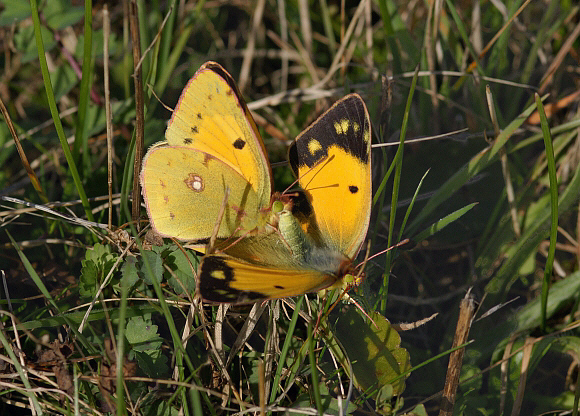
Clouded Yellow, female rejecting male by raising abdomen to prevent copulation – Adrian Hoskins
In late afternoon both sexes seek roosting sites. Sometimes they spend the night beneath bramble leaves or other foliage, but normally they tuck themselves away among grasses. If a large number of Clouded Yellows are present at a site, they often roost in pairs, or even in threes.
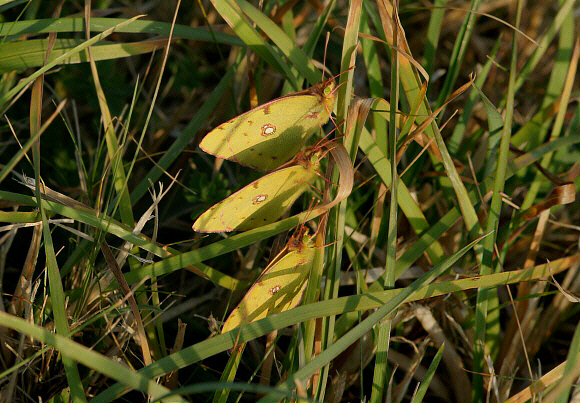
Clouded Yellows Colias crocea at roost, Beachy Head, East Sussex – Adrian Hoskins
